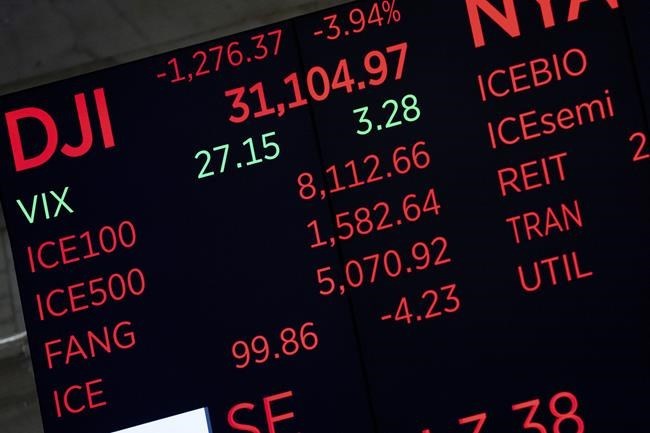NEW YORK — Asian markets skidded lower on Wednesday after Wall Street fell the most since June 2020 as a report showed inflation has kept a surprisingly strong grip on the U.S. economy.
Tokyo’s benchmark Nikkei 225 lost 2.8% in early trading Wednesday, to 27,816.58, while Sydney's S&P/ASX 200 declined 2.5% to 6,834.80. In Seoul, the Kospi lost 2.6% to 2,386.29.
U.S. futures edged higher, with the contracts for the Dow industrials and the S&P 500 up 0.1%. European futures also declined.
On Tuesday, the Dow lost more than 1,250 points and the S&P 500 sank 4.3%. Tuesday's hotter-than-expected report on inflation has traders bracing for the Federal Reserve to raise interest rates still more, adding to risks for the economy.
The steep sell-off didn’t quite knock out the market’s gains over the past four days, but it ended a four-day winning streak for the major U.S. indexes and erased an early rally in European markets.
The S&P 500 sank 4.3% to 3,932.69. The Dow fell 3.9% to 31,104.97 and the Nasdaq composite closed 5.2% lower, at 11,633.57.
Bond prices also fell sharply, sending their yields higher, after a report showed , instead of the 8.1% economists expected.
The yield on the two-year Treasury, which tends to track expectations for Fed actions, soared to 3.74% from 3.57% late Monday. The 10-year yield, which helps dictate where mortgages and rates for other loans are heading, rose to 3.42% from 3.36%.
The hotter-than-expected reading has traders bracing for the Federal Reserve to ultimately raise interest rates more than expected to , with all the risks for the economy that entails.
“Right now, it’s not the journey that’s a worry so much as the destination,” said Brian Jacobsen, senior investment strategist at Allspring Global Investments. “If the Fed wants to hike and hold, the big question is at what level.
All but six of the stocks in the S&P 500 fell. Technology and other high-growth companies fell more than the rest of the market because they’re seen as most at risk from higher rates.
Most of Wall Street came into the day thinking the Fed would hike its key short-term rate by a hefty three-quarters of a percentage point at its meeting next week. But the hope was that inflation was falling back to more normal levels after peaking in June at 9.1%.
Such a slowdown might let the Fed reduce the size of its rate hikes through the end of this year and then potentially hold steady through early 2023.
Tuesday’s report dashed some of those hopes. Many of the data points were worse than economists expected, including some the Fed pays particular attention to, such as inflation outside of food and energy prices.
Markets honed in on a 0.6% rise in such prices during August from July, double what economists expected, said Gargi Chaudhuri, head of investment strategy at iShares.
Traders now see a one-in-three chance the Fed will hike the benchmark rate by a full percentage point next week, quadruple the usual move. No one in the futures market was predicting such a hike a day earlier.
The Fed has already raised its benchmark interest rate four times this year, with the last two increases by three-quarters of a percentage point. The federal funds rate is currently in a range of 2.25% to 2.50%.
Higher rates hurt the economy by making it more expensive to buy a house, a car or anything else bought on credit. have already hit their highest level since 2008, creating pain for the housing industry. The hope is that the Fed can pull off the tightrope walk of slowing the economy enough to snuff out high inflation, but not so much that it creates a painful recession.
Tuesday's data casts doubt on hopes for such a “soft landing.” Higher rates also hurt prices for stocks, bonds and other investments.
Investments seen as the most expensive or the riskiest are the ones hardest hit by higher rates. Bitcoin tumbled 9.4%.
Expectations for a more aggressive Fed also helped the dollar add to its already strong gains for this year. The dollar has been surging against other currencies in large part because the Fed has been hiking rates faster and by bigger margins than many other central banks.
The dollar bought 144.59 Japanese yen, up from 144.57 yen late Tuesday. The euro rose to 0.9973 cents, up from 0.9969 cents.
Oil prices rose. U.S. benchmark crude added 38 cents to $87.69 per barrel in electronic trading on the New York Mercantile Exchange. It lost 47 cents to $87.31 on Tuesday. Brent crude, the international pricing standard, climbed 38 cents to $93.55 per barrel.
___
AP Business Writers Stan Choe, Alex Veiga and Damian J. Troise contributed.
Elaine Kurtenbach, The Associated Press


